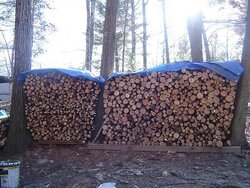Edthedawg said:
oconnor said:
... if you let the flue warm up, then you will get more heat overall, as the system as a whole will be more efficient.
Work on getting the system hot first. Once you are used to getting the system to burn wood well, then work on using it to heat your house.
I still respectfully disagree with this - she stated numerous times that she gets raging flames and that consume the load in short time. If that raging fire isn't heating the stove, and you're claiming it's not heating the flue... where is it going again??
The situation is described as 30+' of liner with rapid fuel consumption and minimal heat output to the room, using dry, 2-3 yr seasoned hardwood.
I'm sorry, but how any of that could be considered poor draft and/or poor wood is beyond me...
Simply put, all we know is that she isn't warm, and that the stove dies when she closes the air.
That is definately not an overfire situation, as the stove would not slow down and cool - overfire is by definition the inability to control the fire, and she can shut it off and turn it on with the air. I believe that the BTU being generated by the burning wood are being used up in evaporating the water in the wood or heating the large stone flue or both, and there is not enough left to keep the occupant warm.
So, Dr House differential Diagnosis time (I love the show, but I think I'm nicer than he is) -
Symptoms - Subject is cold, and closing the air control causes fire to die - she can shut it off and turn it on with the air.
Dollar bill test is a near failure - pulls thru, so it may be a leak into the stove.
Masonary stone flue with full 6" uninsulated liner - large heat sink - takes lots of heat to get it to warm up
There are only 3 variables for fire - heat, air and fuel - the fire triangle
Air is composed of exhaust out which draws air into the stove
Heat is ignition and sustained combustion, of which more heat gives more draft and uses fuel, more draft draws more air and the cycle continues
Fuel is wood - size, species, moisture, positioning are all factors
Dying fire when primary air is closed down - means that there is insuficient heat and air to sustain burn - damp fuel will require more air, and will result in fire dying when air is removed. As well, unintended air entry (leaky door) will cause air to enter in places that stove designer did not intend and may not be used well by the stove - secondary air is designed to enter to sustain the offgas products in combustion, and if air is entering around the door, then not as much will enter via the secondary tubes
Two factors control air - air control rod controls which openings allow how much air into the fire box, and escaping combustion gasses create a negative pressure in the firebox as they leave the flue - AKA draft - changing one changes both, as less air out means less air in, therefore less combustion, and less air out - it increases or decreases until a new balance is achieved, unless it can't sustain combustion, in which case it does out - this is what is happening
Normally closing the air down reduces the primary air entry, and allows more secondary air injection, while the rate of combustion will still sustain enough draft to keep "sucking" air into the box. Total air into the firebox drops, but enough air enters to allow wood to offgass and sustain a burn. In essence, less total air injected in the right place allows for more combustion and more heat, allowing sustained draft because of better use of air and fuel in the stove.
Diagnosis - If there is not enough draft compared to the decrase in available air, then the burn deceases too much, then draft drops, and the process comes to a halt.
Wet wood makes this worse, as water vapour phase change (liguid to steam) receives a lot of btu with minimal increase in temperature (high specific heat), so it essentially "steals" the heat - that means you need more air in to sustain the amount of combustion (heat) needed to keep draft (air) high enough to burn the wet wood (fuel), so you burn wood quickly to maintain enough draft to actually maintain combustion - that doesn't leave enough heat for the occupant to feel warm.
A cold flue makes this worse, as the heat of combustion will leave the rising gasses until the chimney is up to a stable temp. If the chimney is a large heatsink, then it can take a long time for the chimney temp to reach a stable temp - 2- 3 loads of wood is possible if it is all made from the large stone shown in the stove pics.
So, it is either - wet wood, inappropriate air entry (Gasket), or a cold flue that takes a large time to warm up - it is a low draft problem
But in no way is it overdraft - she doesn't have a stove she can't control, but a stove that is over sensitive to control. The small decrease in primary air doesn't allow for sustained temps, so draft drops, and fire goes out. Both damp wood and a cold flue will cause this. The gasket is possible, but not as likely as the other two.
Does this make sense to anyone else? If not, PM me and maybe we can fix the errors without adding another 100 posts to the confusion.




